Dinky Toys: under the microscope
by John Morris
In 2007, Oxford Diecast began to retail it’s new and now, extremely popular models at ‘OO’ 1:76 scale or 76 times smaller than the real thing. The most popular scale for railway layouts. The following year, they began to produce models at the second most popular, ‘N’ scale, which is 148 times smaller than reality. ‘O’ scale, varies between 1:43 and 1:48, smaller by 43 or 48 times. In short, scale means that a measured distance on the ground or of an object is represented by a much smaller distance on paper or electronically.
The choice of scale depends on a range of factors, which include the size of the item, the cost of production for the plan or product and as Jaques Dujardin comments, the size and power of the casting machinery. Therefore, a wide range of scales are used to make realistic and manageable the representation of such widely differing things as trains, boats, planes, cars and trucks, with scales ranging from 1:32 -1,800 and as he comments, with everything (or anything) in between. The concept of integrating diecast models with train sets goes back to 1936 and the launch in the Meccano Magazine of Dinky’s small car series, 35a-d.
Series 35 – Small Cars
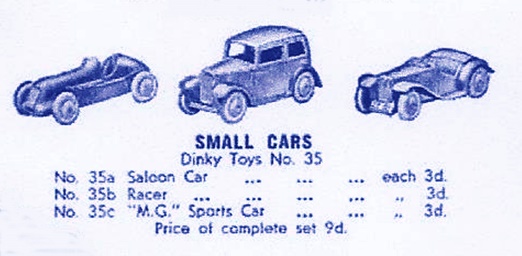
In 1937, the world seemed to appear in just black and white. Colour was a rarity. In the August edition of the Meccano Magazine, Dinky Toys emphasised the importance of the launch of its small car series, 35a, 35b, and 35c, by displaying the models in a blue tinted advertisement on the penultimate page. Dinky introduced the series to enhance the impact of their newly launched ‘00’ electric train sets.
The saloon car (35a) closely resembled an Austin 7, although some say that its front end is more like a Triumph saloon of that era. The second in the series, a racing car has been called an MG Midget, but is more like an MG R-type, which frequently raced on the Brooklands circuit. The sports car is named as an MG midget and reflects the beginnings of a long line of cars and models bearing that name. The small cars series were at a 1:76 scale and were first issued between 1936 and 1941 and then, after the war, from 1945. Initially, each sold for 3d (pence), with the gift set of all three costing 9d.
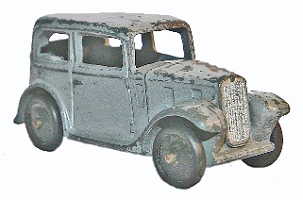
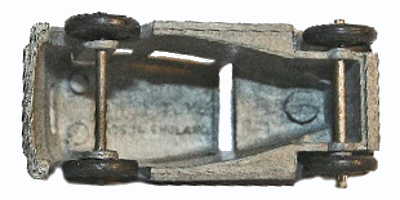
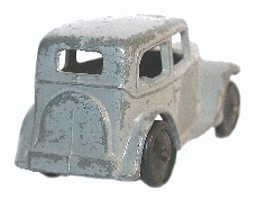
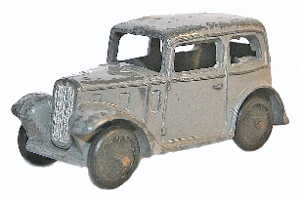
The Austin 7, 35a, came in grey and light blue. The 2 inch (51mm) long saloon car had solid rubber wheels, which were white between 1936 and 1939 but then, black from 1945–1949 and in the North America until 1952, when the model was finally deleted.
In 1953-54, Dinky renumbered the 2 1/4 inch (57mm) long ‘racer’, 35b, as model 200. Although there was no new casting for the post-war re-issue and production of the red painted version, with silver grille, ceased, the silver model, with its red grille, continued through until its withdrawal in 1957.
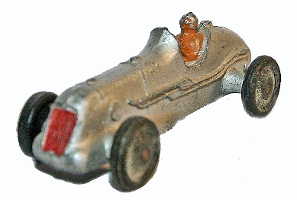
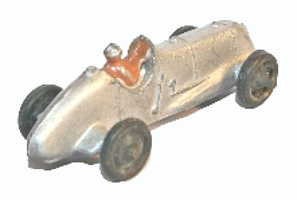
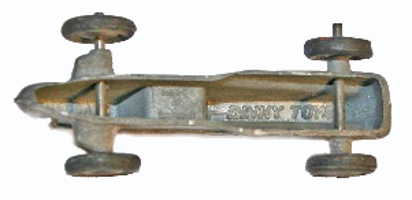
The actual car, often referred to as the ‘Midget’ racer, was more likely to have been an MG R-type, which had an overhead camshaft version of the 1928 Morris Minor and Wolseley 10 engine. The car had a supercharger and 4-speed pre-selector gearbox, ‘Y’ shaped steel chassis, with wishbone and torsion bar suspension, lever arm shock absorbers and cable operated drum brakes.
Model 35c, the 2 inch (51mm) long MG sports car came in red, yellow and light green.
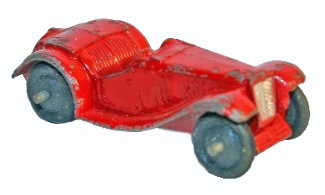
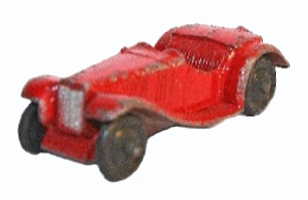
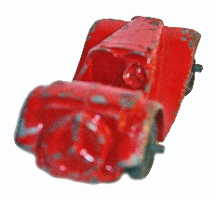
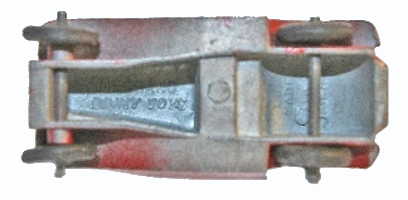
The motoring press of the time described the MG sports car as “Britain’s most talked about sports car”. The 1937 MG catalogue for the Midget T-series announced its price at £222, excluding tax. Dunlop tyres and Triplex safety glass were fitted to the vehicle.
From 1938-48, the small car series had an additional model, 35d, the Austin 7 tourer. First introduced as military reconnaissance vehicle, model 152c, the final car in the series was 2 inches (51mm) long and cost around 4d. The Austin 7 tourer was never included in the boxed set. All of the pre-war versions came with white moulded tyres and had some silver detailing, such as the steering wheel. The 1945 re-issue had black tyres and moulded hubs, a folding windscreen and spare tyre cover.
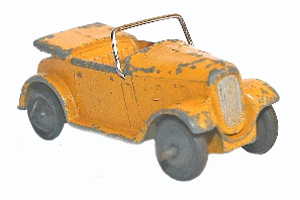
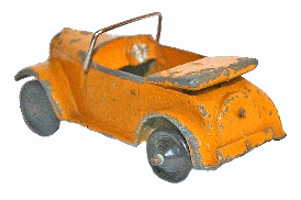
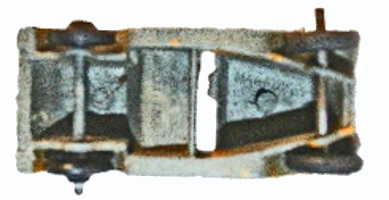
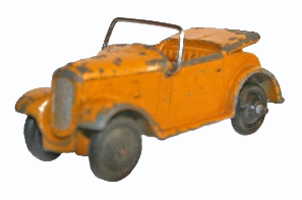
Dinky Dublo
In December 1957, Dinky Toys launch its Dublo range, which was intended to bring together Hornby’s ‘OO’ scale trains with its Dinky Toys to produce models that would enhance any diorama built around railway layouts.

A colour spread in the December 1957 edition of the Meccano Magazine signified the importance of the entirely new, Dublo Dinky Toys launch of the first three models in the series. With each capable of carrying rail freight cargo, such as sand or coal, parcels and luggage or containers.
At a 1:76 scale, these models included the Austin 1 ton truck (064). Based on the K4 Loadstar lorry, the pea green drop-side model had three different types of tyres fitted over its lifetime. The Austin truck, was withdrawn in 1962. Built in 1950, the actual Austin K4 Loadstar truck, was the company’s first post-war lorry. The 3,995cc, 125bhp vehicle came in two formats, the drop-side and the flat bed.
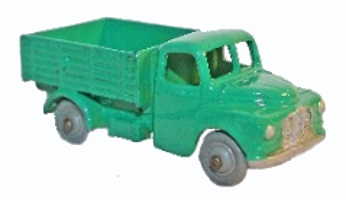
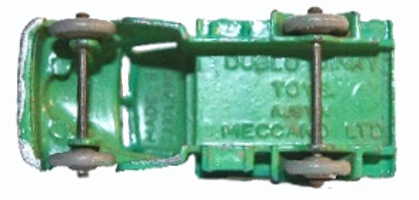
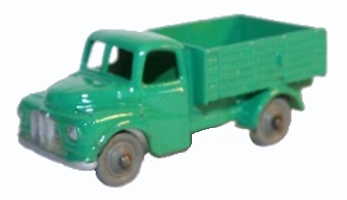
The Morris Minor pickup, 065, featured as the second in the initial batch of models to be released. This 2 3/16 inch model came in crimson red, with smooth grey wheels. The cheese grater grille on this model indicates that the design was based on the mark 1, pre-1954 version, of the Morris Minor pickup. The original cost of 1/9 was reduced to 1/6d by June 1959. Ultimately, the model was withdrawn in 1960.
The grille of the mark 1 pickups and vans was replaced by a slatted grille in both mark 2 and three versions of the Morris Minor, as in the Royal Mail van (068). Morris Minor vans were more robust the cars, because they had a ‘Y’-shaped steel chassis and torsion bar suspension. In 1970, the British Motor Corporation (BMC) ceased production of Morris Minor vans and pickups.
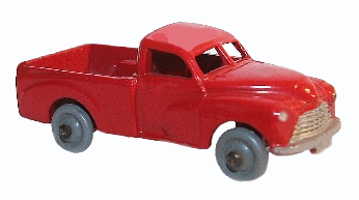
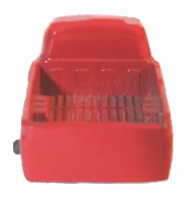
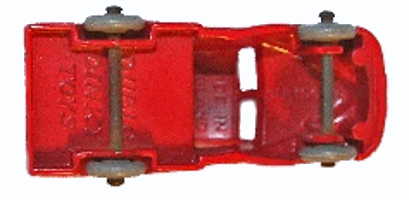
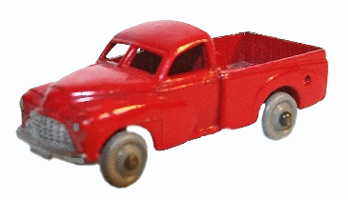
The significance of the Bedford flat truck to the initial launch cannot be over-emphasised, because its flat-bed matched the scale and size necessary to fit the detachable freight container of a D1 low-sided wagon of a Hornby train set. The one piece casting, which made-up the Bedford lorry came only in grey, with smooth grey tyres. Later versions had treaded tyres and some had a hook at the rear. The model was withdrawn in 1966.
Dinky based their model on the Bedford D series, 5 ton, long wheelbase truck, which had a 4,927 cc Bedford diesel engine. In 1957, the actual lorry cost around £1,370, excluding tax.
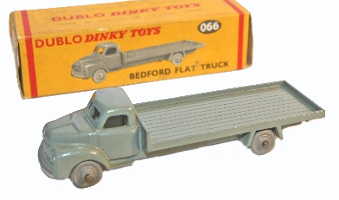
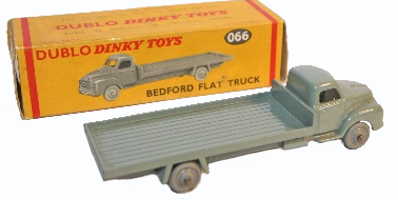
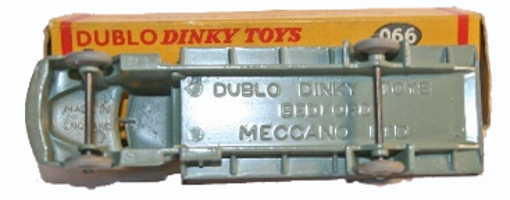
| Model | Number | Launch Date | Length | Type of tyre | Cost |
|---|---|---|---|---|---|
| Ford Prefect | 061 | Feb. 1958 | 2 3/16 inches (56mm) | Smooth grey | 1/9 |
| Singer roadster | 062 | Feb. 1958 | 2 inches (51mm) | Smooth grey | 1/9 |
| Commer van | 063 | Feb. 1958 | 2 1/16 inches (52mm) | Smooth grey | 1/9 |
| Austin 4 ton truck | 064 | Dec. 1957 | 2 ½ inches (64mm) | Smooth grey, treaded grey, black treaded | 1/9 |
| Morris pickup | 065 | Dec. 1957 | 2 3/16 inches (55mm) | Smooth grey | 1/9 |
| Bedford flat bed | 066 | Dec. 1957 | 4 ¼ inches (108mm) | Smooth grey, treaded grey | 2/- |
| Austin Taxi | 067 | Mar. 1959 | 2 5/16 inches (59mm) | Treaded grey, black treaded | 2/6 |
| Royal Mail van | 068 | Apr. 1959 | 1 7/8 inches (48mm) | Treaded grey | 2/3 |
| Massey-Harris-Ferguson Tractor | 069 | Jun. 1959 | 1 7/16 inches (37mm) | Treaded grey | 1/6 |
| AEC Shell/BP tanker | 070 | Oct. 1959 | 3 5/8 inches (92mm) | Treaded grey, black treaded | 2/6 |
| Volkswagen delivery van | 071 | Mar. 1960 | 2 1/8 inches (54mm) | Treaded grey, black treaded | 2/- |
| Bedford articulated flat bed | 072 | Jun. 1959 | 4 5/8 inches (118mm) | Treaded grey, black treaded | 2/6 |
| Land Rover and Horse Trailer | 073 | Sept. 1960 | 4 5/8 inches (118mm) | Smooth grey, treaded grey, black treaded | 4/3 |
| Lansing Bagnall tractor and trailer | 076 | Jun. 1960 | 2 7/8 inches (73mm) | Black treaded | 2/9 |
Released in April 1959, the Royal Mail van was advertised as being just right to fit Hornby’s ‘OO’ gauge railway. With grey, moulded non-scratch, treaded wheels, the model sold for around 2/3. The model was also fitted with smooth grey and black wheels. The model was withdrawn in 1964.
Based on the Morris 6-8cwt van, manufactured between 1948 and 1971, this 1098cc vehicle was the workhorse of the Royal Mail throughout the 1960s and early 1970s. In 1972, the last delivery of over 700 of these vans to Royal Mail took place.
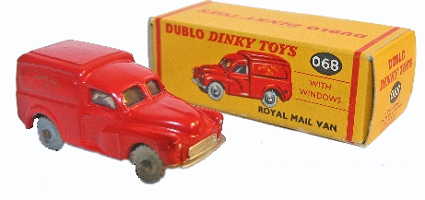
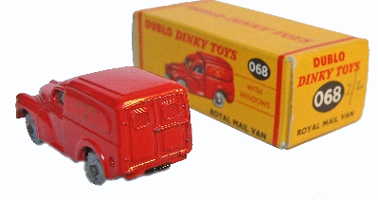
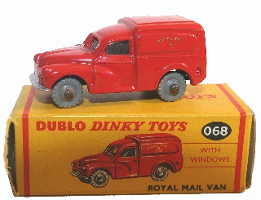
The concept of providing ‘OO’ scale models to enhance railway layouts held through to 1960 and the production of the final model in the series, the Lansing Bagnall platform tractor and trailer. Dinky did not intend for this model to be the last in the series. Produced between 1960 and 1964, the maroon platform tractor and trailer had black treaded tyres and blue driver on a blue seat, although occasionally the seat has been painted black.
In 1943, Lansing Bagnall was bought out of bankruptcy for £3,000. Now part of the Linde AG group, Lansing Bagnall manufactured the diesel powered tractor and trailer at small workshops in London’s Mortlake and Isleworth districts, before moving to Basingstoke in 1949. At their Merthyr Tydfil plant, Lansing Bagnall built the larger, 5-8 ton, side-loaders and container handling vehicles.

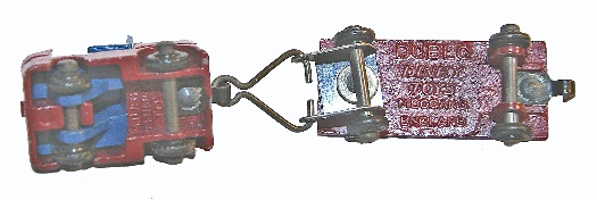
Dinky did not intend for this model to be the last in the series. Models 074 and 075 were destined to be the Land Rover and horse trailer sold separately. Dinky intended model 077 to be a bulk cement carrier based on the AEC tanker, 070, but this was never produced. Had they done so, the livery might have been that of Blue Circle Cement. However, Tunnel Cement is more likely, because they did use AEC tankers, but not in the style chosen by Dinky.
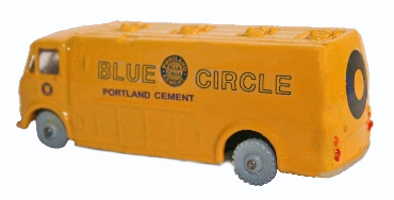
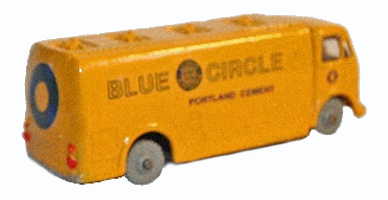
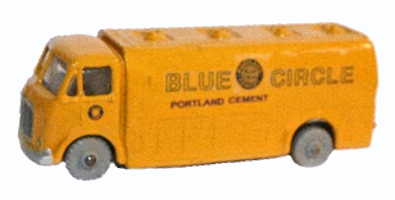
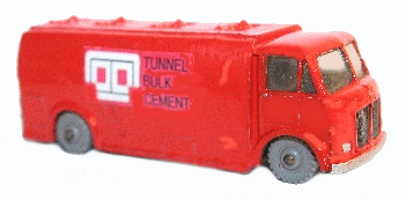
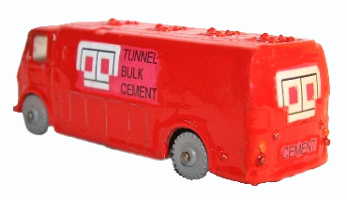
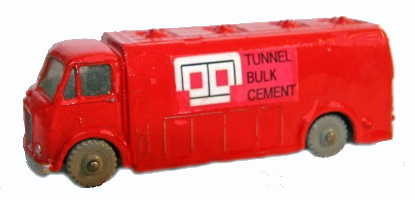
Instead Lines Brothers, after their takeover of Dinky Toys, phased out the Dublo series, because it just couldn’t compete with Matchbox. With the rationalisation by Lines Brothers, an end came to Dinky’s production of small scale cars, trucks and tractors.
Classic French Dinky Toys
Among French Dinky’s models, the vast majority are at ‘O’ scale, around 1:43 or 1:48. Only two stand out as being different, although even one of them is at a 1: 43 scale. It just happens that the vehicle it represents is unusually small in the first place.
In 1939, French Dinky launched the 60mm long Simca 5, Topolino, (35a). The casting at a scale of 1:55 moulded details of the model into its one piece shell. With either white of black hubs and rubber tyres, the model cost 125 fr. (old francs), about 2/6. Between 1940 and 1948, the price remained, even though the wheels became black metal. After 1948, the black wheel hubs had solely black tyres. The model came in a range of colours including grey, red, dark green, royal blue, yellow, gold, silver and brown. The bodywork, doors, hatches, vents, grille and headlights are embossed. Ultimately, the Simca 5, Topolino, was deleted in 1949.
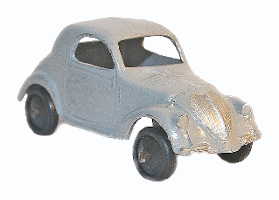
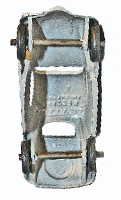
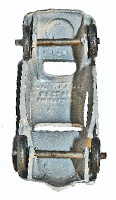
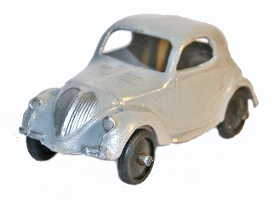
Designed by Fiat and known in Italy as the Topolino, the Franco-Italian, SIMCA 5, was built in Nanterre between 1939 and 1948. The in line 570cc engine produced a remarkable fuel consumption of 110km on only 5 litres of petrol. The car had a four speed gearbox, independent suspension, drum brakes and a 12v electrical system. Pre-war production slowed due to industrial action and German occupation. Eventually, the car was delisted in 1949 and replaced by the SIMCA 6.
Advertised in the 1962 French Dinky catalogue, the Leskokart, 512, a 34mm long model cost 3.00 fr. (new francs). As the smallest Dinky Toy produced at a scale of 1:43, it was sold in the smallest box. The blue cast chassis and silver engine came with a moulded plastic, bucket seat and plastic driver came in three colours; red, yellow and light blue. The model was withdrawn in 1966.
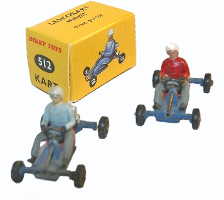
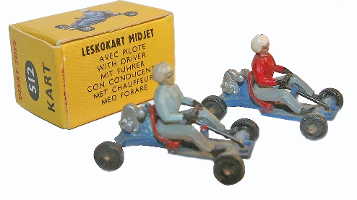
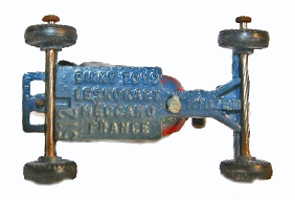
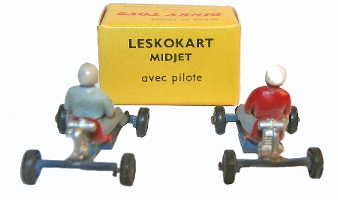
In 1956, an American, Arts Ingels, had the idea of assembling pieces of tubular steel on four wheels and powering this primitive vehicle with a small, McCulloch lawn mower engine. Some versions of these early go-karts were even powered by chain-saw motors. French Dinky chose to model the Leskokart, because George Lescovac produced the first all French Kart in a workshop at St. Ouen, in a northern suburb of Paris. Powered by a 50cc, two-stroke Lavelette engine, which cost 950 fr. (new francs), the Kart could reach speeds around 40kmph.
In the scale of things to come
Lines Brothers ceased production of the Dublo series, because they believed that it did not catch the public’s imagination and therefore, could not compete with Matchbox. The range became restricted, with models listed for only a couple of years. This represented the end of Dinky’s integration of diecast models with ‘OO’ scale train sets. Rightly, Jacque Dujardin comments that Dinky had no methodology for extrapolating scale and in consequence, they used everything and anything, which led to models having proportions that were larger than in the real world. An example is the 1/16th inch pillar for the split screen Morris Minor pickup, 065, which in reality was little more than an inch wide chrome strip, would have had a width of almost 5 inches. French Dinky did not succumb to producing ‘00’ scale vehicles. Both the SIMCA 5 and the Leskokart, although small in comparison to other French Dinky models, were at ‘O’ scale, 1:43.
One might ask whether the notion of linking train sets and diecast models was ever likely to have a mass appeal. Equally, creating dioramas for train sets seems inconsistent with the other intention of providing pocket-money sized toys, in which case full-size Dinky Toys provided better value for money. The Meccano magazine exposes Dinky’s perspective, which appears to be based on a pre-war vision of suburban, pipe-smoking fathers assisting their sons, who wore grey shorts and Fair Isle jumpers, building railway layouts and dioramas; sadly, a vision with no place for girls. Dinky’s response contrasts to that of Oxford Diecast, which clearly reduces production costs and have a policy of constantly improving the relevance and quality of their product selection. In short, Dinky seemed to have done insufficient market research, leaving questions about management’s clarity of purpose and the quality of advice given by their ideas team. The big question appears to be, was this the beginning of the end for Dinky?